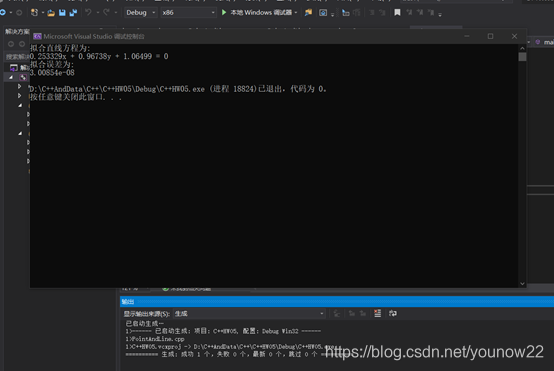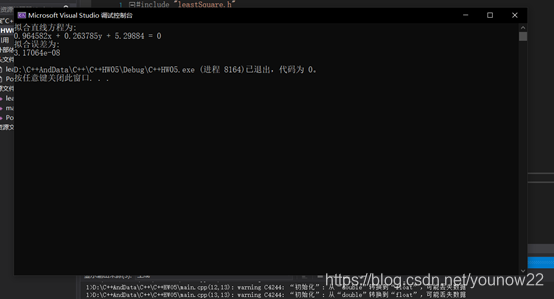设计思路
- 一个平面点由两个坐标(x,y)确定,请编写一个表示平面点的类Point。要求:
- 在默认构造函数中初始化类对象为原点(0,0);
- 添加一个带参数的构造函数,传入两个坐标值。
- 添加拷贝构造函数。
- 添加赋值操作函数operator=。
- 为类的两个成员添加getter函数和setter函数,getter函数为const函数;
- 平面直线的方程为ax+by+c=0 ,请设计一个类Line,表示一条平面直线。要求:
- 在默认构造函数中初始化直线为x轴。
- 添加一个带参数的构造函数,传入直线方程的三个系数。
- 添加拷贝构造函数。
- 添加赋值操作函数operator=。
- 添加一个函数,获取直线的方向
。
- 添加一个函数,获取该直线的三个参数。
- 添加一个函数,计算点到直线的距离,函数的参数是第一题的Point类对象。
- 添加一个函数,判断一个点是否在这条直线上,函数的参数是第一题的Point类对象。提示:由于存在计算误差,当点到直线的距离小于一个很小的阈值时,可以认为点在直线上。
- 编写一个函数,用于生成一组随机点Pi=xi,yi,i=1…m ,这些随机点都是某一条直线l:ax+by+c=0上 的点,但是受到很小的噪声污染,即,
,其中ηi
是一个很小的噪声,服从0均值高斯分布(使用std::normal_distrubtion生成满足高斯分布的随机数来模拟这个噪声,参考:http://www.cplusplus.com/reference/random/normal_distribution/)。函数的输入为一个Line对象,样本点数目,输出为随机点数组。提示:使用vector<Point>传回生成的随机点对象数组。
- 编写一个函数FitLine,该函数传入一组随机点,返回一条直线。该直线是采用最小二乘法,用传入的随机点拟合的直线。
- 编写一个函数CalcDistance,计算一组点到一条直线的平均距离。
- 在main函数中,生成一个Line对象L0,并调用上述函数生成随机点集,然后调用你的FitLine函数拟合出直线L1。并用CalcDistance函数计算你所得到的直线L1与样本点集之间的拟合误差(即平均距离)。在main函数中,输出真实直线L0的方程,拟合直线L1的方程,以及拟合误差。
本实验需要了解的算法知识如下:
源码
Main.cpp
//Main.cpp
#include "leastSquare.h"
#include <iostream>
#include<ctime>
#include<random>
using namespace std;
using namespace leastSquare;
using namespace PointAndLine;
int main(int argc, char* argv[])
{
srand(time(0));
float ran1 = 0 + 1.0 * (rand() % RAND_MAX) / RAND_MAX * (1 - 0);
float ran2 = 0 + 1.0 * (rand() % RAND_MAX) / RAND_MAX * (1 - 0);
float ran3 = 0 + 1.0 * (rand() % RAND_MAX) / RAND_MAX * (1 - 0);
PointAndLine::Line L0(ran1,ran2,ran3), L1;
vector<Point> ptr = GenRanPoint(L0, 100);
L1 = FitLine(ptr);
float dis = CalcDistance(ptr, L1);
float a, b, c;
L1.getter(a, b, c);
cout << "拟合直线方程为:" << endl;
cout << a << "x + " << b << "y + " << c <<" = 0" << endl;
cout << "拟合误差为:" << endl;
cout << dis << endl;
return 0;
其他文件和函数
leastSquare.h
//leastSquare.h
#ifndef _LEASQU_H_
#define _LEASQU_H_
#include<iostream>
#include <vector>
#include"PointAndLine.h"
using namespace PointAndLine;
using namespace std;
namespace leastSquare
{
vector<Point> GenRanPoint(Line l, int num);
Line FitLine(vector<Point> ptr);
float CalcDistance(vector<Point> ptr, Line l);
}
#endif
leastSquare.cpp
//leastSquare.cpp
#include"leastSquare.h"
#include<cmath>
using namespace leastSquare;
float gaussrand()
{
static float V1, V2, S;
static int phase = 0;
float X;
if (phase == 0) {
do {
float U1 = (float)rand() / RAND_MAX;
float U2 = (float)rand() / RAND_MAX;
V1 = 2 * U1 - 1;
V2 = 2 * U2 - 1;
S = V1 * V1 + V2 * V2;
} while (S >= 1 || S == 0);
X = V1 * sqrt(-2 * log(S) / S);
}
else
X = V2 * sqrt(-2 * log(S) / S);
phase = 1 - phase;
return X;
}
vector<Point> leastSquare::GenRanPoint(Line l, int num)
{
float a, b, c;
l.getter(a, b, c);
float theta = gaussrand();
vector<Point> p;
for(int x = 1;x<num+1;x++)
{
x = static_cast<float>(x);
float y = static_cast<float>((-a / b) * x - (c / b) + theta);
Point index(x, y);
p.push_back(index);
}
return p;
}
Line leastSquare::FitLine(vector<Point> ptr)
{
float x = 0, y = 0, A = 0, B = 0, beta = 0;
for(unsigned int i=0;i<ptr.size();i++)
{
x += ptr[i].getter_x();
y += ptr[i].getter_y();
}
x = x / ptr.size();
y = y / ptr.size();
for (unsigned int i = 0; i < ptr.size(); i++)
{
A += pow(x - ptr[i].getter_x(), 2);
B += (y - ptr[i].getter_y())*(x - ptr[i].getter_x());
}
beta = static_cast<float>(sqrt(pow(A, 2) + pow(B, 2)));
const float a =static_cast<float>( -B / beta);
const float b = static_cast<float>(A / beta);
const float c = -a * x - b * y;
Line line(a,b,c);
return line;
}
float leastSquare::CalcDistance(vector<Point> ptr, Line l)
{
float distance = 0;
for(int i = 0;i < ptr.size();i++)
{
distance += l.calcDistance(ptr[i]);
}
distance = distance / ptr.size();
return distance;
}
PointAndLine.h
#ifndef __PAL_CPP_
#define _PAL_CPP_
#include <cstdlib>
#include <cstddef>
namespace PointAndLine
{
class Point
{
private:
float x, y;
friend class Line;
public:
Point() :x(0), y(0) {}
Point(float _x, float _y);
Point(const Point& p);
Point& operator=(const Point& p);
float getter_x()const;
float getter_y()const;
void setter(float _x, float _y);
};
class Line
{
private:
float a, b, c;
public:
Line():a(0),b(1),c(0){}
Line(float _a,float _b,float _c);
Line(const Line& l);
Line& operator=(const Line& l);
void getter(float& _a, float& _b,float& _c)const;
float calcDistance(Point p);
bool point_In_line(Point p);
};
}
#endif
PointAndLine.cpp
//PointAndLine.cpp
#include"PointAndLine.h"
#include<iostream>
#include<cmath>
using namespace std;
using namespace PointAndLine;
Point::Point(float _x,float _y)
{
this->x = _x;
this->y = _y;
}
Point::Point(const Point &p)
{
x = p.x;
y = p.y;
}
Point& Point::operator=(const Point& p)
{
if(this==NULL)
{
x = p.x;
y = p.y;
}
return *this;
}
float Point::getter_x() const
{
return x;
}
float Point::getter_y() const
{
return y;
}
void Point::setter(float _x,float _y)
{
x = _x;
y = _y;
}
Line::Line(float _a, float _b, float _c)
{
a = _a;
b = _b;
c = _c;
}
Line::Line(const Line& l)
{
a = l.a;
b = l.b;
c = l.c;
}
Line& Line::operator=(const Line& l)
{
if(this!=NULL)
{
a = l.a;
b = l.b;
c = l.c;
}
return *this;
}
void Line::getter(float& _a, float& _b, float& _c)const
{
_a = this->a;
_b = this->b;
_c = this->c;
}
float Line::calcDistance(Point p)
{
return static_cast<float>(abs(a * p.x + b * p.y + c) / sqrt(pow(p.x, 2)+pow(p.y, 2)));
}
bool Line::point_In_line(Point p)
{
if(a*p.x+b*p.y+c<static_cast<float>(1e-1))
{
return true;
}
return false;
}
运行结果
5个拟合点:
100个拟合点:




